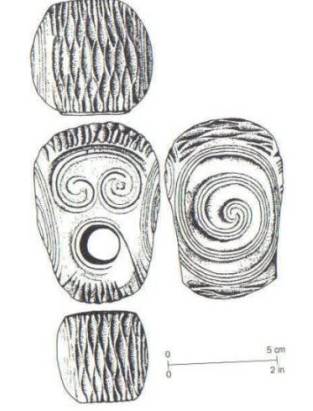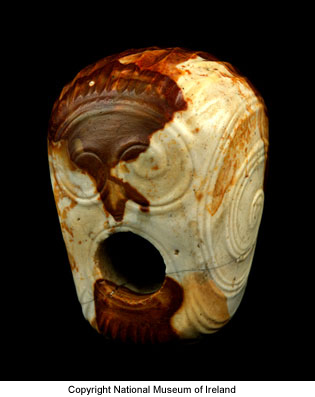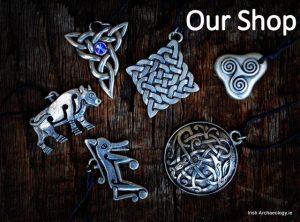This stunning flint macehead was found deep within the darkest recesses of the great Neolithic passage tomb at Knowth, Co. Meath. Hidden for millennia, it was discovered in 1982 during an excavation carried out by Dr George Eogan. It is fashioned out a single piece of pale-grey flint, splashed with patches of brown, and is polished and decorated on all six sides.
The principle motifs employed are finely carved spirals and lozenges. On one side these symbols appear to form a human face, with the shaft hole defining a wide, gaping mouth. This object represents one of the finest artifacts from Neolithic Europe and it displays a high level of both technical and artistic sophistication.
Measuring 7.90 cm in length and weighing approximately 324 g[i], the macehead has as cylindrical perforation towards its narrower end, which would have held a wooden handle. An object of exceptional craftsmanship the mace-head was probably a prestigious symbol of religious or political authority[ii].

It was discovered by Mr Liam O’Connor, who found it sitting on the old ground surface between two large stone jams that defined the entrance into the northern recess of the tomb. It was sealed by a deposit of chipped shale that appeared to have been deliberately thrown down to hide the object[iii]. A short distance away, and at the same stratgraphic level, was a small cremation pit. It is possible that this burial was broadly contemporary with the deposition of the macehead[iv], although this is not definite.
Unsurprisingly, the artifact caused quite as stir when found, with the then Taoiseach, Mr Charles Haughey, visiting the excavation especially to see it. It is now housed in the National Museum of Ireland, Kildare Street, Dublin where it can be viewed by members of the public, free of charge.

.
[i] Eogan, G. & Richardson, H. 1982 ‘Two Maceheads from Knowth, Co. Meath’ in The Journal of the Royal Society of Antiquaries of Ireland, Vol. 112, pp. 124
[ii] Waddel, J. 1998. The Prehistoric Archaeology of Ireland, Galway University Press, Galway, p. 74
[iii] Eogan, G. & Richardson, H. 1982 ‘Two Maceheads from Knowth, Co. Meath’ in The Journal of the Royal Society of Antiquaries of Ireland, Vol. 112, p. 123
[iv] Eogan, G. & Richardson, H. 1982 ‘Two Maceheads from Knowth, Co. Meath’ in The Journal of the Royal Society of Antiquaries of Ireland, Vol. 112, p. 123




How in the world did they finish that incredible piece? The workmanship is amazing, but what tools and processes did they use so adeptly?
It looks like a fancy meat tenderizing hammer. How chilling.
The craftmanship indicates that it was made in the late Neolithic Copper Age. The closest analogies are the very finely worked rock crystal and flint arrowheads found in the Montelirio Tholos in south Spain. See paper by Leonardo Garcia Sanjuan et al. available through Academia.com.
I agree with Bob Dibble that this piece is amazing. The precision cutting of flint would be very difficult to replicate even using modern diamond cutting heads and robot technology. This was made at the end of the stone age and the craftsmen were using a vast knowledge of stone working techniques accrued over several millenia. This understanding was lost when metal casting techniques were invented in the late Copper and Bronze Ages. It may have involved the discovery of the erosive power of hydrofluoric acid. This extremely poisonous acid is produced by the reaction of mineral Fluorite with sulphuric acid. Beware. Fluorite from Berbes, Asturias, Spain, one of the classic fluorite localities in Europe.
It looks like the big giant head out of Rick and Morty
Dear all,
My name is Edward Lynch an Irish archaeologist an I would like to suggest that the Knowth Mace Head is actually a ritual or ceremonial drum head.
I would appreciate all thoughts on this theory.
Kind regards,
Edward
Edward,
I only have a few lower level anthropology courses under my belt but, to reply and add to your thoughts, could it possibly have been a ceremonial mace head but thusly used as a drum head? I could imagine that if it had great significance, being a symbol of strength/prestige/power, that using it in such a way could be used to bring praise to a god/goddess?
v/r,
Ryan